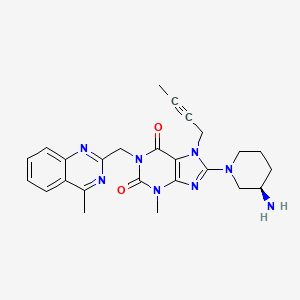Type 2 diabetes mellitus
Adult: As monotherapy or in combination with other antidiabetic agents: 5 mg once daily.
|
Indications and Dosage
Oral
Type 2 diabetes mellitus Adult: As monotherapy or in combination with other antidiabetic agents: 5 mg once daily.
|
|
Administration
May be taken with or without food.
|
|
Contraindications
Hypersensitivity.
|
|
Special Precautions
Patient with a history of pancreatitis and angioedema with another dipeptidyl peptidase-4 (DDP-4) inhibitor. Patients who are at risk of having heart failure (e.g. history of renal impairment or heart failure). Not indicated for use in patients with type 1 diabetes mellitus or diabetic ketoacidosis. Pregnancy and lactation.
|
|
Adverse Reactions
Significant: Heart failure (increased risk of hospitalisation); severe and disabling arthralgia; bullous pemphigoid.
Gastrointestinal disorders: Constipation, mouth ulceration, stomatitis. Hepatobiliary disorders: Cholecystitis. Investigations: Increased serum lipase, amylase. Musculoskeletal and connective tissue disorders: Rhabdomyolysis, myalgia. Respiratory, thoracic and mediastinal disorders: Cough. Skin and subcutaneous tissue disorders: Rash, urticaria, alopecia. Potentially Fatal: Hypersensitivity reactions (e.g. anaphylaxis, angioedema, exfoliative skin conditions, bronchial hyperreactivity); acute pancreatitis (e.g. haemorrhagic and necrotising cases). |
|
Patient Counseling Information
This drug may cause an impaired ability to react due to hypoglycaemia, if affected, do not drive or operate machinery.
|
|
Monitoring Parameters
Monitor HbA1c (at least twice yearly in patients with stable glycaemic control and are meeting treatment goals or quarterly for patients not meeting their treatment goals or with changes in therapy). Consider a combined evaluation of HbA1c with a blood glucose test and/or a glucose management indicator for patients who are prone to glycaemic variability (e.g. insulin deficiency) or those with HbA1c that is contradictory with the serum glucose levels or symptoms. Monitor blood pressure. Assess for signs and symptoms of hypoglycaemia, pancreatitis (e.g. persistent, severe abdominal pain), heart failure (shortness of breath, swelling of feet), serious hypersensitivity reactions (e.g. angioedema, anaphylaxis), or bullous pemphigoid (e.g. erosions, blisters).
|
|
Drug Interactions
Increased risk of hypoglycaemia when combined with insulin and/or insulin secretagogues (e.g. sulfonylureas). Decreased plasma concentration and reduced efficacy with rifampicin. Increased exposure with ritonavir.
|
|
Action
Description:
Mechanism of Action: Linagliptin is a selective inhibitor of dipeptidyl peptidase-4 (DPP-4), an enzyme responsible for the degradation of incretin hormones such as glucagon-like peptide-1 (GLP-1) and glucose-dependent insulinotropic polypeptide (GIP). These incretin hormones increase the synthesis and release of insulin from pancreatic β-cells and reduce glucagon secretion from pancreatic α-cells, hence their prolonged and increased levels upon DDP-4 inhibition result in the physiological regulation of glucose homeostasis. Pharmacokinetics: Absorption: Rapidly absorbed from the gastrointestinal tract. Bioavailability: Approx 30%. Time to peak plasma concentration: 1.5 hours. Distribution: Extensively distributed to the tissues. Plasma protein binding: 99% (low concentration); 70-80% (high concentration). Metabolism: Not extensively metabolised. Excretion: Mainly via faeces (80% as unchanged drug); urine (5% as unchanged drug). Elimination half-life: Approx 12 hours; approx 200 hours (terminal). |
|
Chemical Structure
 Source: National Center for Biotechnology Information. PubChem Compound Summary for CID 10096344, Linagliptin. https://pubchem.ncbi.nlm.nih.gov/compound/Linagliptin. Accessed Oct. 23, 2023. |
|
Storage
Store between 15-30°C.
|
|
MIMS Class
|
|
ATC Classification
A10BH05 - linagliptin ; Belongs to the class of dipeptidyl peptidase 4 (DPP-4) inhibitors. Used in the treatment of diabetes.
|
|
References
Anon. Linagliptin. AHFS Clinical Drug Information [online]. Bethesda, MD. American Society of Health-System Pharmacists, Inc. https://www.ahfscdi.com. Accessed 29/08/2023. Anon. Linagliptin. Lexicomp Online. Hudson, Ohio. Wolters Kluwer Clinical Drug Information, Inc. https://online.lexi.com. Accessed 29/08/2023. Buckingham R (ed). Linagliptin. Martindale: The Complete Drug Reference [online]. London. Pharmaceutical Press. https://www.medicinescomplete.com. Accessed 29/08/2023. Joint Formulary Committee. Linagliptin. British National Formulary [online]. London. BMJ Group and Pharmaceutical Press. https://www.medicinescomplete.com. Accessed 29/08/2023. Linagliptin 5 mg Film-coated Tablets (Zentiva Pharma UK Limited). MHRA. https://products.mhra.gov.uk. Accessed 29/08/2023. Tradjenta Tablet, Film Coated (Boehringer Ingelheim Pharmaceuticals, Inc.). DailyMed. Source: U.S. National Library of Medicine. https://dailymed.nlm.nih.gov/dailymed. Accessed 29/08/2023. Trajenta 5 mg Film-coated Tablets (Merck Sdn. Bhd.). National Pharmaceutical Regulatory Agency - Ministry of Health Malaysia. https://www.npra.gov.my. Accessed 29/08/2023.
|